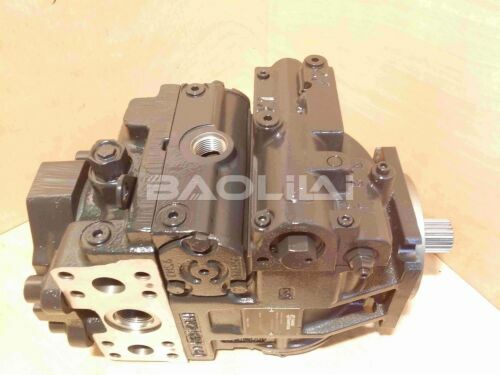Transmission mode of hydraulic pump
The transmission mode of the hydraulic pump refers to the way the power is transmitted from the input shaft to the hydraulic components of the pump. There are three main transmission modes of hydraulic pumps:
Direct Drive: In a direct drive system, the input shaft of the hydraulic pump is directly connected to the hydraulic components of the pump, such as the piston or impeller. This results in power being transferred directly from the input shaft to the hydraulic components without the use of any gears or other mechanical components.
Belt Drive: In a belt drive system, the input shaft of the hydraulic pump is connected to a pulley or pulley, which is then connected by a belt to the pump's hydraulic components. Belts are used to transmit power from the input shaft to the hydraulic components of the pump.
Gear Drive: In a gear drive system, the input shaft of the hydraulic pump is connected to a set of gears, which in turn drive the hydraulic components of the pump. Gear drives are commonly used in high-pressure hydraulic systems because of their ability to provide high levels of power transmission with minimal slip or wear.
90R250-KA-5-CD-80-T-4-C8-K-09-NNN-14-23-24 90R250KA5CD80T4C8K09NNN142324
90-R-250-KA-5-CD-80-T-4-C8-K-03-NNN-35-35-24 90R250KA5CD80T4C8K03NNN353524
90R250-KA-5-CD-80-T-4-C8-K-03-NNN-35-35-24 90R250KA5CD80T4C8K03NNN353524
90-R-250-KA-5-CD-80-T-4-C8-J-05-NNN-29-29-24 90R250KA5CD80T4C8J05NNN292924
90R250-KA-5-CD-80-T-4-C8-J-05-NNN-29-29-24 90R250KA5CD80T4C8J05NNN292924
90-R-250-KA-5-CD-80-T-4-C8-J-05-NNN-26-26-24 90R250KA5CD80T4C8J05NNN262624
90R250-KA-5-CD-80-T-4-C8-J-05-NNN-26-26-24 90R250KA5CD80T4C8J05NNN262624
90-R-250-KA-5-CD-80-T-3-F1-K-03-NNN-42-42-30 90R250KA5CD80T3F1K03NNN424230
90R250-KA-5-CD-80-T-3-F1-K-03-NNN-42-42-30 90R250KA5CD80T3F1K03NNN424230
90-R-250-KA-5-CD-80-T-3-F1-K-00-NNN-29-14-24 90R250KA5CD80T3F1K00NNN291424
Each transmission mode has its own advantages and disadvantages, depending on the specific application. For example, direct drive systems are often simpler and more efficient than belt or gear drive systems, but may be limited in their ability to handle high pressure or heavy loads. Belt drive systems, on the other hand, are generally quieter and more flexible than other transmission methods, but can be less efficient and more prone to wear over time. Gear transmission systems are often used in high-pressure applications where efficiency and durability are critical, but can be more complex and expensive than other transmission modes.
In addition to the above three main transmission modes, there are also hybrid transmission systems that combine elements of two or more transmission modes. For example, some hydraulic pumps use a combination of belt and gear drives to provide flexibility and durability.

The choice of hydraulic pump transmission mode depends on a number of factors, including the desired output pressure, flow and operating conditions. For example, for low-pressure applications with relatively low flow rates, a direct drive system may be sufficient, while for high-pressure applications with higher flow rates, gear transmission may be required.
It is also important to consider factors such as reliability, efficiency and maintenance requirements when selecting a transmission for a hydraulic pump. For example, gear transmissions are generally very reliable and efficient, but may require more maintenance than other transmission modes to ensure optimum performance.
Overall, the delivery mode of a hydraulic pump plays a vital role in determining the pump's performance and suitability for a particular application. By carefully selecting the appropriate transmission mode according to the specific requirements of the application, efficiency, reliability and durability can be maximized while minimizing maintenance requirements and downtime.
90R250-KA-5-CD-80-T-3-F1-K-00-NNN-29-14-24 90R250KA5CD80T3F1K00NNN291424
90-R-250-KA-5-CD-80-T-3-F1-J-09-NNN-42-42-24 90R250KA5CD80T3F1J09NNN424224
90R250-KA-5-CD-80-T-3-F1-J-09-NNN-42-42-24 90R250KA5CD80T3F1J09NNN424224
90-R-250-KA-5-CD-80-T-3-F1-J-03-NNN-35-35-24 90R250KA5CD80T3F1J03NNN353524
90R250-KA-5-CD-80-T-3-F1-J-03-NNN-35-35-24 90R250KA5CD80T3F1J03NNN353524
90-R-250-KA-5-CD-80-T-3-F1-J-03-NNN-14-14-24 90R250KA5CD80T3F1J03NNN141424
90R250-KA-5-CD-80-T-3-F1-J-03-NNN-14-14-24 90R250KA5CD80T3F1J03NNN141424
90-R-250-KA-5-CD-80-T-3-C8-K-03-NNN-42-42-24 90R250KA5CD80T3C8K03NNN424224
90R250-KA-5-CD-80-T-3-C8-K-03-NNN-42-42-24 90R250KA5CD80T3C8K03NNN424224
90-R-250-KA-5-CD-80-T-3-C8-K-03-NNN-38-38-24 90R250KA5CD80T3C8K03NNN383824
Another important consideration when selecting a hydraulic pump delivery mode is the type of fluid being pumped. Some fluids, such as abrasive or corrosive fluids, may require specialized materials or coatings to ensure pump component durability. This affects the choice of transfer mode, as certain modes may be better suited to handle these types of fluids.
In addition, the operating environment of the hydraulic pump is also an important factor to consider when selecting the transmission mode. For example, in environments with high levels of dust or other contaminants, direct drive systems may be more prone to wear and damage than gear or belt drive systems, which can be enclosed for additional protection.
It is also important to consider the overall system design and layout when selecting a transmission mode for a hydraulic pump. For example, belt drives are more flexible and better suited to complex system designs than gear drives, which require more precise alignment and positioning.
In summary, the way a hydraulic pump is driven plays a vital role in the performance, reliability and durability of the pump. By carefully considering factors such as operating conditions, fluid type, and system design, the most appropriate transmission mode can be selected for a given application and ensures optimum performance and efficiency of the hydraulic system.
This article is published by the official website of Baolilai Hydraulics, please contact the author and indicate the source for reprinting:https://www.baolilai-pump.cn/news/347.html






